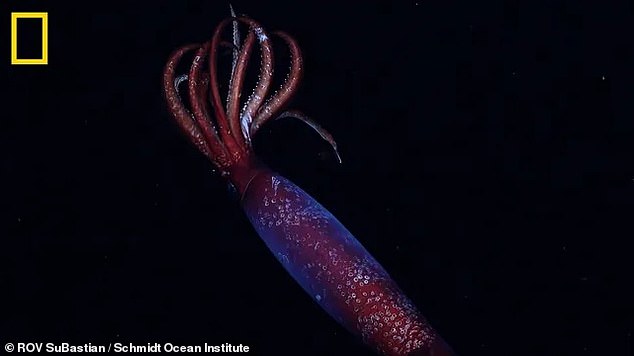Scientists have captured the first ever footage of an elusive Antarctic squid living beneath the Southern Ocean.
The rare Antarctic gonate squid was spotted more than 7,000 feet (2,152 metres) deep in the freezing waters off Antarctica.
This is the first time that this blood-red, hook-tentacled species has ever been seen alive in its natural habitat.
The secretive creature was spotted by researchers aboard the Schmidt Ocean Institute’s research vessel, the R/V Falkor (too).
The scientists had intended to search for life inside a 9,800-feet-deep (3,000 metres) depression near Antarctica’s northern tip called the Powell Basin.
However, when thick sea ice prevented their passage, the team were forced to deploy their remote-operated vehicle (ROV), SuBastian, which made the stunning discovery.
Footage of the squid was sent to Kat Bolstad, a squid expert from Auckland University of Technology, who identified it as an Antarctic gonate squid.
Dr Bolstad told National Geographic: ‘This is, to the best of my knowledge, the first live footage of this animal worldwide.’

Scientists have captured the first ever video of the elusive Antarctic gonate squid, 7,060 feet (2,152 metres) beneath the freezing Southern Ocean
Although scientists have known about the existence of Antarctic gonate squid for over 100 years, all the evidence about their lives comes from dead specimens.
The squid have been found in fishermen’s nets or preserved in the stomachs of other animals, but never alive in the wild.
Scientists believe that these creatures spend most of their lives living in the midnight or bathypelagic zone, between 3,300 and 13,100 feet down (1,000 to 4,000 metres).
At these extreme depths, the only light is that produced by the strange animals which live there.
The ROV spotted this rare squid drifting just outside of the Powell Basin on Christmas Day last year, at a depth of 7,060 feet (2,152 metres).
Likely startled by the ROV’s bright lights in its usually dark habitat, the squid released a cloud of greenish ink as the craft approached.
The researchers followed the squid for a few minutes, using the ROV’s lasers to make a rough measurement of its size.
After a short while, the Antarctic gonate squid drifted off into the inky darkness.

Antarctic gonate squid were only known through dead specimens found in nets and in pieces preserved in the stomachs of other predators. This is the first time that the rare ambush hunter has been seen in the wild
Although they weren’t able to determine the animal’s sex or age from this brief encounter, it was enough to determine its species.
In particular, Dr Bolstad was able to recognise it as an Antarctic gonate squid due to the large hooks at the end of its two longer tentacles.
Researchers believe that it uses these hooks to snatch up fish and even other squid.
Alex Hayward, an ecologist from the University of Exeter, says: ‘The impressive tentacle hooks are probably used for grasping and subduing prey during ambush predation.’
The squid also has exceptionally large eyes that it uses to make out the tiniest hints of light, both to spot prey and avoid any potential predators.
‘Daily life is probably a mixture of an active predatory lifestyle, trying to catch fish to eat, whilst avoiding voracious predators,’ adds Dr Hayward.
The footage also revealed that the squid bore the scars of a recent battle, including sucker marks on its mantle and arms.
Although the exact species that caused these injuries isn’t certain, scientists believe it could have been a juvenile colossal squid.

Scientists say that the Antarctic gonate squid might have been injured by an attack from a juvenile colossal squid, which was seen for the first time in the wild earlier this year (pictured)
Read More
Elusive colossal squid is seen live in the deep sea for the first time EVER

Early this year, the Schmidt Ocean Institute’s ROV SuBastian recorded the first ever footage of a colossal squid near this location.
Colossal squid can grow up to 23 feet (7 metres) and weigh as much as 500kg, making them the heaviest invertebrates on the planet.
The 11-inch-long (30cm) baby colossal squid was spotted north-east of the Powell Basin, off the coast of South Georgia.
Colossal squid are known to feed on their smaller cousins, making them a likely culprit for the attack on this Antarctic gonate squid.
